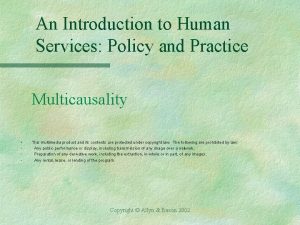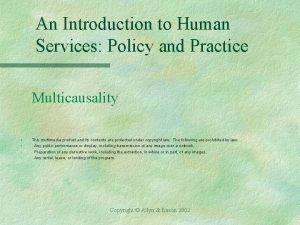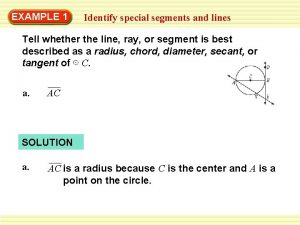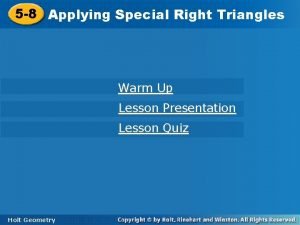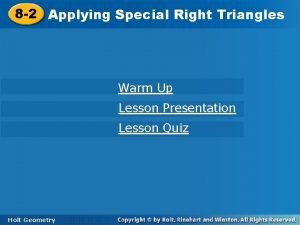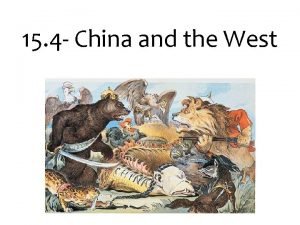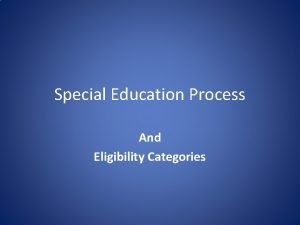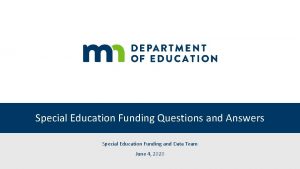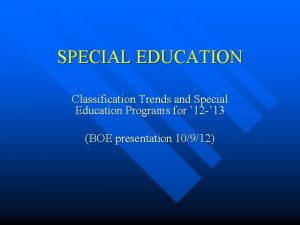Special Education Policy Practice in China Policy and








- Slides: 8

Special Education Policy & Practice in China

Policy and Law Identification Categories Teacher preparation Inclusive Education Advocacy

Currently, a three-part model encompassing special schools, special classes, and LRC (Learning in Regular Classrooms随 班 就 读 )-with LRC as the main strategy-has gradually been supported as the national policy for special education (State Council, 1989; Y. Xu et al. , 1995). • What are your experiences with inclusive practices in China? Do you find that students with disabilities are being served in their “LRC”? Why or why not? • What kind of challenges are school and teachers facing under the current law and special educational model? • Is this a policy/practice that can practically (politically, technically, & culturally) implemented in China?

Much like the United States, teachers in China often have the responsibility of educating students with disabilities. These teachers often have limited prior knowledge and experiences with students with disabilities when they begin their teaching career. How can we best help these teachers and students succeed in the classroom? • How can teacher preparation be changed to be more effective for all students, including those with different abilities? • How can we teachers to identify students with unidentified disabilities ? • Are there significant differences in how general educators and special educators are trained? Should they be trained together or separately?

Current laws and policies only define five disability categories (visual impairment, hearing and speech impairment, physical disability, mental retardation, psychiatric disability), while some other types of disabilities (e. g. , learning disability, autism) were not clearly identified or defined. What problems might this cause? • Disability categories in China seem to focus on “visible” disabilities instead of “invisible” disabilities. Why do you think that is and why might it be problematic? • The medical model of disability is highlighted. How do you think that this impacts instructional practices, disability categories, and teacher preparation? • How does the identification of disabilities compare or contrast to the practices of the United States?

Curriculum, instructional methods, and academic standards are identical for all students in hopes to prepare students to succeed in the stiff competition of high stakes testing for grade promotion and college admissions in China. How do you think this impacts students? • What are some possible ways to address learning diversity under this testing uniformity and to practice individualized teaching & assessment for these students with disabilities? • Is high stakes testing the best or only way to assess students? • This high stakes testing and competitive academic environment often leads to student tracking (i. e. vocational or academic) or student dropout. How does this practice impact students (with or without disabilities), the workforce, and China as a whole?

What’s the best way to effect change? • How is current attitude towards students with disabilities shaped by geographic, political, philosophical (e. g. Confucian philosophy), and historical ideas? • How can we raise people’s awareness and change attitudes? • What is the best method to effect this change? Should we focus on a top down approach (government standards, policies, and laws) or a bottom up approach (teacher training, parent advocacy, and community support)? • The United States and the UK are host to many international student education scholars. How do we ensure that the knowledge, research, and innovations that these students & researchers are making, create international change?

Teacher preparati on Policy and Law Inclusive Education Policy and Law Identific ation/C ategorie s Inclusive Education Advocacy Teacher preparation
 An introduction to human services policy and practice
An introduction to human services policy and practice Multicausality in human services
Multicausality in human services Physical activity was historically primitive.
Physical activity was historically primitive. Myeplg website
Myeplg website Skew segments example
Skew segments example Lesson 4 multiplying special cases
Lesson 4 multiplying special cases Applying special right triangles
Applying special right triangles Special right triangles simplest radical form
Special right triangles simplest radical form 7-3 practice special right triangles
7-3 practice special right triangles
